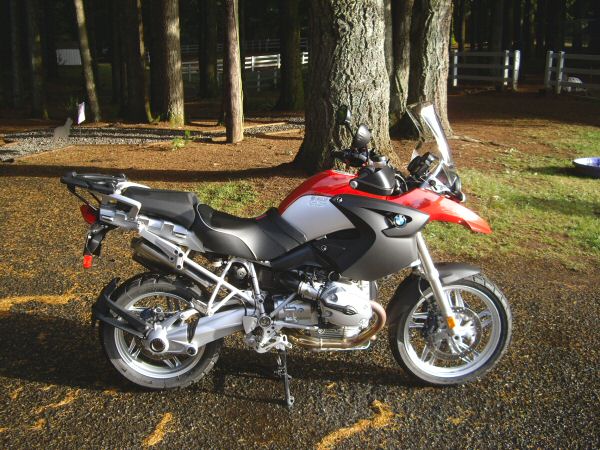
The 2006 BMW R1200GS

My R1200GS pictured here in October 2006, with a new Sargent Seat
Overview
The R1200GS is the latest configuration in a series of "adventure" motorcycles manufactured by BMW, starting with the R80GS in 1980. When first introduced, the R1200GS won many awards including the 2004 Cycle World International Bike of the Year. It is built around BMW's latest boxer engine, an opposed twin cylinder engine virtually synonymous with BMW. One look at the engine, and you know it's a Beemer (as they're affectionately known).
The R1200GS engine includes many refinements over previous models. The 1170cc engine is oil-cooled, producing 100 bhp and 85 lbs/ft of torque. It now includes a gear-driven counter balancer that removes much of the vibration typically associated with opposed twin engines. The hex-shaped cylinder heads enclose 4 valves per cylinder, and utilize an enhanced dual spark ignition system to improve engine performance and fuel mileage.
The GS is fuel injected, and includes a computerized engine management system that automatically controls various settings for optimal performance. Input from two oxygen sensors (one in each exhaust manifold) help the computerized system control performance and emissions. Although meant to run on premium unleaded gasoline, the engine management system automatically modifies settings to allow the use of lower octane (and even leaded) fuels if needed.
The bike has a six-speed transmission, and 2006 enhancements include helical gears and improved gear ratios. This results in a transmission that's smoother than its predecessors, with more evenly spaced gearing from first through sixth. It uses a single-plate dry clutch to aid in shifting. Getting the power from the engine to the rear wheel is accomplished using a shaft drive enclosed within the Paralever swing arm, which includes an additional pivot point between the final drive and the swing arm. This technology reduces the typical up and down motion that most shaft drive motorcycles impart when accelerating and braking. The "uni-style" swing arm extends only on the right hand side of the motorcycle.
Front suspension uses BMW's Telelever design that basically eliminates suspension dive under hard braking. This results in a very stable and precise riding feeling that lets you feel confident in all types of riding conditions. The Telelever front suspension provides 7.5" of travel, and the rear Paralever suspension provides 7.9" of travel. Both front and rear suspension are adjustable.
My bike came with cast alloy wheels with tubeless Michelin Anakee tires. The front wheel is 19" in diameter, and the rear is 17". As an option, BMW also offers cross-spoke wheels that can also utilize tubeless tires.
My GS also came with BMW's Integral Anti-lock Braking System (ABS). This servo-assisted braking system helps to prevent locking up the front and rear brakes in adverse conditions. In addition, it allows the front brake lever to control both the front and rear brakes (the footbrake lever controls the rear only). For off-road riding, you can turn the ABS system off, although you have to turn the motorcycle off to do so.
My GS included heated handgrips and handguards (nice for early morning and cold-weather riding). The instrument cluster includes a speedometer, tachometer, and small flat-screen display. The display provides information on the oil temperature, the transmission gear engaged, time of day, and fuel level. When the tank empties to the reserve level, the fuel level display switches to tell you approximately how many miles you can ride before empty. The display also includes an odometer that can be toggled to show one of two tripometers. The instrument cluster illuminates automatically as needed.
2006 BMW R1200 Specification Sheet
